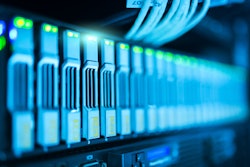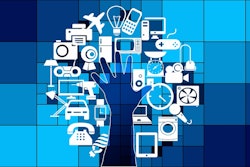
While often touted as the latest and greatest technology to ever hit the supply chain, the Internet of Things (IoT) really isn’t new, says Guy Courtin, vice president of Industry, Retail and Fashion and Infor Retail-GT Nexus. He explains the effort to further connectivity within the supply chain and into retail, actually began when Wrigley put a barcode, which is really the first form of IoT, on a pack of gum, and it was scanned in a supermarket in Ohio.
What is new, however, is that the price of connectivity dropped, lightning fast cellular networks are widely available and sensors are small and easily placed just about everywhere. This is the real reason supply chain is seeing an explosion of IoT use, Courtin adds.
“Now, the IoT can do more than provide a passive understanding of transactions. It can provide data that enables us to better monitor and understand usage, and understand and anticipate demand at a much higher level,” he says.
He shares an example of how usage data might be used from a recent conference involving an IoT-enabled electric toothbrush. This futuristic brush tells users when they missed a spot and need to go back and brush an area again. This data goes back to the manufacturer, who might use the information to partner with Crest to supply consumers with toothpaste coupons after 30 days of brushing correctly. If they learn from this data that the consumer is using more toothpaste than expected, Crest can ship toothpaste to him or her before he or she runs out.
This may be a Jetsons-like example of how IoT data might be used, but Courtin says retail is starting to head in this direction as the IoT gives manufacturers and retailers more than just point-of-sale (POS) data. Where barcodes used to provide information on when a product was scanned, where it was purchased and who purchased it, the IoT can now monitor or understand usage patterns to anticipate demand and fulfillment needs, and eventually, “paint an even richer picture of how consumers are using products and how and when they’re going to start demanding them.”
The need for a demand-driven supply chain is going to be increasingly necessary as retail markets become more competitive and customer loyalty drops, while customer demands increase. These changes require retailers to tighten up their planning windows from months to weeks to days and hours.
Fortunately, the IoT can make this possible by capturing and storing real-time granular data to enable companies to generate demand-sensing insights. This information can be used in a whole host of business decisions, including making inventory reallocation decisions to prevent out-of-stock situations, tracking inventory in real time across the supply chain, and in deploying inventory to the right distribution center or warehouse.
Identify Your Problems
But using data to derive actionable supply chain insights begins before the first 1s and 0s are in hand. Courtin says, “There is way too much information out there. The first question must be going through business uses to determine what specific data to be looking for. It’s not a one-size-fits-all solution.”
Companies, he says, need to set goals before collecting data. “They need to know the problems they are trying to solve so they can develop a solution for them,” he says. “If it’s just basic replenishment, they want to focus on usage data. But if they want to get more sophisticated, they are going to need to go beyond how fast they are depleting an item, and understand how the customer is actually using it.”
Grocery stores know customers buy eggs, for example. They know how often they run out of eggs, but imagine what that grocery store owner could do if he or she knew if a customer was using the eggs to bake cakes, make omelets, bake cookies or throw at their neighbor’s house. “This information can help a consumer packaged goods (CPG) retailer know how to approach a specific customer,” he says.
Refining the Data
There’s a saying that if “I pour oil out of Saudi Arabia, it does me no good until I refine it.” The same is true for IoT data; it does no one any good until it’s refined by data analytics and demand management tools, and analyzed, says Courtin.
Here the goals identified in the first step play a critical role. “The question becomes what are they going to feed that oil so that it gets refined? And how are they going to put it back into the system so that they do something with it,” he says. “Are they going to use the data to improve customer service? Will using it to build customer loyalty? Are they going to use the information to build manufacturing or supplier relationships? Or is it going to be used to improve internal operations? There are a whole host of places you could use this refined data.”
One area where Courtin sees IoT data being particularly useful is in inventory, specifically in forecasting and in the estimated time of arrival and outages. He says a lot of time is wasted trying to figure out why a shipment has not yet arrived. “There are still a lot of blind spots in the process,” he says. Take Fed Ex for instance. Though you have a tracking number available to you, and you get updates periodically, there are still times where you have no idea where your product is. It’s the same with truckloads of retail products.
“The IoT can eliminate those blind spots,” he adds, “By putting smart sensors on pallets or containers, on trucks and in warehouses, it gives the user an understanding of exactly where something is at any point in its lifecycle of this supply chain. I can start getting more granular in understanding when things are going to arrive, why they don’t arrive and what the delay might be, and I can start rebalancing my supply chain in real time.”
Short-term demand might be one of the first areas the IoT would be useful, adds Karin Bursa, vice president of marketing for Logility. “Companies can collect actual usage or demand information from a device and aggregate that data together to create a demand signal. This can help identify in the short term what daily demand or near-term replenishment might look like.”
It also might be useful in demand validation or as part of a collaborative planning environment. A supplier may have a collaborative vendor management inventory program underway, and it can bring in in replenishment material to be used in the product that gets packaged and shipped to retail. The data collected by the IoT can automate that process, says Bursa, and also identify patterns that can be compared to the expected demand plan for the business.
Bursa is quick to add, however, “This does not replace the need to do demand planning and forecasting. The whole premise of doing a demand plan or forecasting is so you can source, produce, store if needed and deliver to the customer inside that customer’s lead time,” she says. “Even with the IoT sensing demand closer to its actual need, you still have lead time associated with production and the distribution of your goods to customers.” The data simply firms up the demand or forecasted plans for the business, she says, so that companies can validate it and adjust.
Finally, the IoT can be used in promotional demand, that is when a consumer goods manufacturer, for example, runs a promotion with its grocery retail customers. In these situations, demand spikes and might increase by 3 to 300 percent. “The manufacturer can say, ‘I’ve got three to five times my normal product flow coming in for this promotion with my retail partner, so I want to keep my finger on the pulse of what this looks like, and if I find myself in a shortage situation, I may need to prioritize,’ ” Bursa adds.
The IoT holds great promise in the demand-based supply chain, but first companies need to set goals, determine the right data to collect, figure out what it means to them and then apply this knowledge to help make business decisions that make sense. While Courtin is correct in saying the IoT has been around for a very long time, supply chain hasn’t begun to use it to its fullest potential—yet.




















